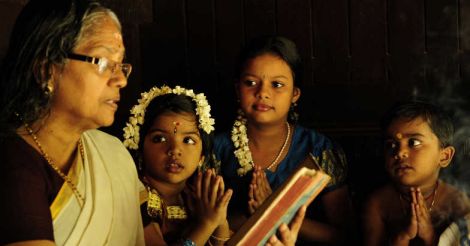Ramayana is an epic that dwells in detail about the complex relations of truth and dharma -- which may be roughly described as moral propriety. In a way, more than a divine story, it is more in tune with humans and their mental transactions. The epic revolves around Rama, the embodiment of dharma, who faces challenges in behaving as per dharma because of his many roles and circumstances in life.
Rama goes to the forest in exile as demanded by his father, who is forced to demand so. The young prince, who was to attain the throne, goes in exile wholeheartedly to keep the dharma of a son. While in exile, he gives his footwear to the crown prince Bharata, who refuses to assume the throne, as part of dharma a brother should keep. He annihilates demons which is the dharma of a kshatriya-a warrior- and he kills Bali, the invincible, to keep his dharma as a friend. He killed Ravana to keep the dharma of the brave and when he attained his throne after 14 years of exile, he struck to the dharma expected of a king all through his remaining life. This way, Rama adhered to dharma in all phases of his life and in his land, all including animals, got justice and peace.
The story goes that there was a bell in Ayodhya, which people in distress could ring in order to receive resolutions to their problems from Rama, the king. One day, a dog rang the bell and on inquiry, it was revealed that a saint had hit it, injuring it. Rama called the saint to the palace and enquired about his role in the event and the saint said, 'I was in search of alms when this dog was blocking my way. I asked it to move, but it did not and I beat it.'
Knowing that the saint had committed a mistake, Rama asked the dog what punishment should be meted out to the saint and the dog replied, 'There is a Shiva temple in the extreme limit of your kingdom. Please make him the administrator of that temple.' Rama was puzzled because it did not seem to be a punishment, but a status.
The dog went on, explaining his demand, 'In my last birth, I was a priest in that temple and once without any reason, I wasted a leaf, which landed me the life of a dog in this birth. This person is not divine and he will do a lot of fraud if made the administrator of that temple. Consequently, he would receive a life much worse than a dog in his next birth.'
There are many similar stories but they are not part of Valmiki Ramayana, but other 'Ramayanas' based on the original Ramayana. There are so many Ramayanas such as Ananda Ramayanam, Kamba Ramayanam, Adhyatma Ramayanam, Thulasidasa Ramayanam and so on. All of them have a story and sub plots. Ananda Ramayanam and Padmapuranam details how Rama and Sita lived happily after she was rescued from Lanka. For Keralites, the Ramayana that is most dear to them is the version of Ezhuthachan. The lines are simple and beautiful and the verses overflow with devotion. In a particular line, the poet draws a comparison between a frog and humans. Even when being swallowed by a snake, the frog searches for food; likewise, even when being engulfed by the snake-like time, humans are engrossed in sensory desires of the world. All through the work, deeper aspects of human life is exposed to us in simple language and examples that are easy to understand.

Sundara Kaandam (or book) in Ramayana talks about the exploits of Hanuman when he goes in search of Sita in Lanka. Sundara also means messenger and talks about Hanuman who goes as the messenger of Rama into the impregnable fort of Ravana in Lanka. Hanuman, the embodiment of devotion, is able to breach Ravana's fort and create havoc. He returns after delivering the message of Rama to those who matters. When Rama wants to bless Hanuman for his exploits, he requests Rama that he remain alive as long as the name of Rama is taken by people in the world. That belief continues to this day when people read the Ramayana. The front row of the audience is left out for Hanuman, who is believed to be present wherever Rama's name is taken.
The characters in Ramayana are unique. Sita symbolises the all-forgiving nature of women. She sacrifices all her happiness for the family and takes refuge in the earth only when she is overwhelmed by circumstances. In contrast is Sumitra, wife of Dasaratha, who is sidelined all through her life in spite of being more abled than the three wives of Dasaratha. She never complains all her life. Her voice is heard only once in Ramayana when she advices her son Lakshmana, who is preparing to go in exile with his elder brother, Rama and his sister-in-law, Sita. Sumitra who earlier advices Lakshmana to go into exile because he can be in the company of Rama, says, " treat the forests as Ayodhya, Rama as your father and Sita as me." That single advice has immortalised Sumitra in Ramayana.
When criticising Rama, one of the important argument against him is whether he did justice to all his dharmas. When he is preparing to go into exile, he is prevented from doing so by his mother, Kausalya, who says, "You are the only heir to my kingdom in Kosala, so please do not go." However, he disobeys his mother, breaking his dharma as a son. Similarly, when he kills Bali through treachery and deceit, he is not seen adhering to the dharma of a kshatriya, a righteous soldier. When he abandons Sita in the forest because of hearsays and rumours, he is seen breaching the dharma of a husband and in the process, he deviates from the dharma of a father that he is expected to show to his unborn children. Finally, he even denounces Lakshmana who had been his shadow for years, vacillating from the dharma of an elder brother.
The epic speaks about the challenges, choices and decisions that one has to make in the face of challenges. While Rama is led by dharma, he is not able to abide by dharma in many instances because of the circumstances in his life. Dharma was the power and weakness of Rama at the same time, whatever be the inferences that others draw of his actions in various stages of his life.




































































































































































































































































































































































































































































































































































































































 The epic revolves around Rama, the embodiment of dharma, who faces challenges in behaving as per dharma because of his many roles and circumstances in life.
The epic revolves around Rama, the embodiment of dharma, who faces challenges in behaving as per dharma because of his many roles and circumstances in life.
Disclaimer
The comments posted here/below/in the given space are not on behalf of Manorama. The person posting the comment will be in sole ownership of its responsibility. According to the central government's IT rules, obscene or offensive statement made against a person, religion, community or nation is a punishable offense, and legal action would be taken against people who indulge in such activities.